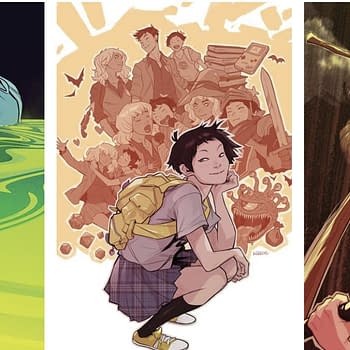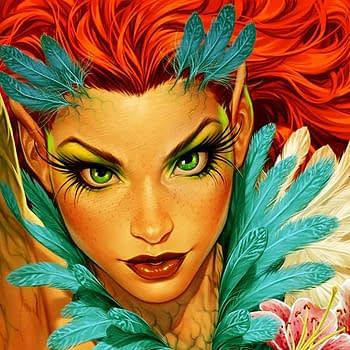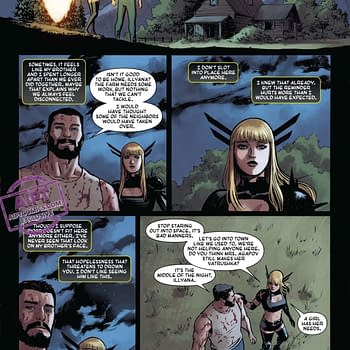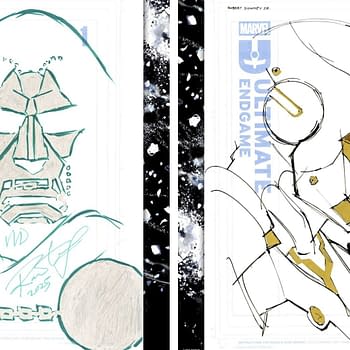Posted in: Comics | Tagged: Comics, dynamite, entertainment, Margo Lane, matt wagner, the shadow
Matt Wagner Shows Us The Shadow's Darker Side
Matt Wagner talks about his return to the iconic pulp hero in The Shadow: The Death of Margo Lane #1 (of 5), on sale in June from Dynamite.

MATT WAGNER: Well, Margo's a bit of a controversial character to longtime Shadow fans. Of course, The Shadow was the first and most successful in the eventual explosion of "Hero Pulps." But, at the same time, the character was featured in an enormously popular radio show. Margo was The Shadow's "constant friend and companion" on the radio program (mainly because our hero needed someone to talk to for expositional purposes), but she was absent from the original pulp novels. Eventually Walter Gibson, who — writing under the in-house pen name of "Maxwell Grant" — was basically the creator of The Shadow as he's presented in the pulps and author of the vast lion's share of the three hundred-plus stories produced over the years, yielded to publisher pressure and introduced Margo as one of The Shadow's many agents. I found when it was time to write The Shadow: Year One series that I needed to distill and combine a lot of the disparate elements from the many interpretations of The Shadow in various media. So I set Margo up as one of The Shadow's earliest agents who ultimately becomes his lover and confident. As his most intimate comrade, Margo's loss will definitely prove to be a huge crack in The Shadow's seemingly impenetrable veneer. One of the elements I included in my portrayal of The Shadow's history comes from the 1994 Alec Baldwin film—the fact that the character has a definite dark and violent past that, through his own determination and training with eastern mystics, he has managed to redirect and contain. He has, literally, harnessed this shadow side of himself in the pursuit and defense of justice. And, as I said, Margo's death will shatter his ironclad resolve and threaten to unleash The Shadow's darker side.
BB: Fans of the Shadow have always seen him mostly in control, very cool and unemotional. But this loss is close to his heart. How did you meet the challenge of bringing us what I would suspect to be a rather different Shadow?
MW: Yeah…as a character, The Shadow presents a bit of difficulty in that he comes across as so infallible and unstoppable. The Shadow is a larger-then-life force who's always one step ahead of we mere mortals and who never seems to lose. I mean, the character's most famous catchphrase is, "The Shadow knows!" Margo Lane acts as a vital element in that she's consistently been my narrator of The Shadow's adventures. Much like Sherlock Holmes, I think it's vitally important that we never be inside The Shadow's head, that we never have access to his internal thoughts as that destroys the character's mystique. And so Margo acts as my Watson, giving us intimate insight into (the man posing as) Lamont Cranston and his cloaked adventures. And…she's his lover as well. When the radio show famously credited Margo as The Shadow's "constant friend and companion", 1930s audiences knew exactly what that meant. Her presence humanizes The Shadow in a way that makes him much more accessible to readers and I think that's really important. I thought it was important that we realize that he isn't a spirit or a supernatural force. He's a man. A very, very capable and powerful man but still flesh-and-blood. Margo, as a character, helps ground him in that regard. Here again, the character can prove to be a hard one for readers to empathize with. His adventures are, no question, thrilling and entertaining…but it can be hard to actually feel for the man beneath the slouch hat. For such a fiercely solitary personality, it must be hard to realize that you'd become so attached to another person, so dependent on their presence as a stabilizing influence in your life. So hard, one might say…to realize that you were in love. I'm happy to say, I think I've pulled off a difficult narrative turn with this series; you actually feel sympathy for The Shadow! And nothing too maudlin or sappy…that wouldn't fit the character at all. But readers will definitely feel and realize his immense sense of loss.
BB: You will be in both author and artist seat this time around, with your son Brennan coloring. Can you let us in on the process of how this Dad & Son duo create the Master of Darkness together?
MW: Brennan and I have a very close relationship, both personally and professionally. Of course, he grew up in my house and my studio so he's very familiar with the way I think and create. We speak the same language when it comes to art and so working together is always smooth. I'm very proud of him; he's developed into an enormously talented colorist who gives a lot of consideration to story-telling as well as drama and mood. He's colored a ton of the stuff I've written in recent years—The Shadow: Year One, the Django/Zorro series and he's currently working on the relaunch of Will Eisner's The Spirit that I wrote. He had colored a variety of my covers as well but Grendel vs. The Shadow was the first sequential work of mine that he colored. He's done just a fantastic job on all of those and I'm thrilled to be working with him again on this project. For this series — The Death of Margo Lane — we've worked closely together and struck an all-new and very specific color palette that doesn't look quite like any of the work I mentioned above. It's very noirish and, I think, lends a dramatic pulp atmosphere to the story as a whole, striking a tone that's both urban and somewhat ghostly.
BB: This is by no means your first Shadow tale. What is it about the pulps in general, and the Shadow in particular, that makes him such a favorite of creators, of yourself?
MW: The pulps were, of course, the precursors of the modern comic book narratives, thrilling tales about desperate heroism and decadent villainy. I first discovered The Shadow when I was 12 or 13…a very impressionable age and right around the time you start making lifelong connections to various aspects of pop culture. This was the early 70s, long before comics took on a darker edge and tone and The Shadow was the first character who, debuting forty years earlier, broke the traditional mold for a hero. He dressed like Dracula and readily wielded guns to deal with bad guys, and he laughed maniacally while doing so! My first exposure came when DC Comics started their classic run of the title, cleverly written by Dennis O'Neil and beautifully drawn by Michael Kaluta. At around the same time, various episodes of the old radio program started to become available on LP vinyl. And then Pyramid Books began reprinting the original pulp novels with gorgeous painted covers by Jim Steranko. So, I really got an ultra dose of The Shadow, all in the span of just a couple of years. Since then, the character has been a perennial favorite for me and I find I really love contributing to his legacy in my own way. Between the pulps, the immensely popular radio show and the various comic incarnations over the years, there are many different facets to The Shadow, all of which I try to distill together in my version.
In closing, I'd like to say that this series should appeal to both new readers as well as longtime fans. The story is a perfect jumping-on point if you're a reader who's had some interest in The Shadow but might not know where to begin. This tale has a profound effect on The Shadow and his merciless war on crime…the cost of which will prove devastating.














